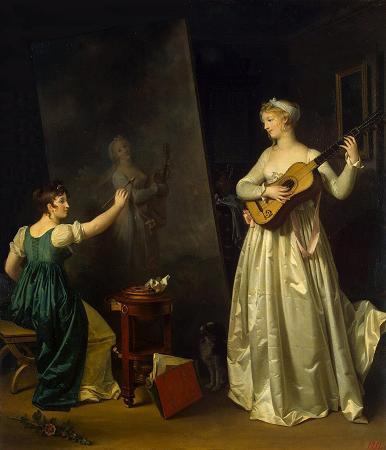Genre with Painter. The history of painting reaches back in time to artifacts and artwork created by pre-historic artists, and spans all cultures. It represents a continuous, though periodically disrupted, tradition from Antiquity. Across cultures, continents, and millennia, the history of painting consists of an ongoing river of creativity that continues into the 21st century. Until the early 20th century it relied primarily on representational, religious and classical motifs, after which time more purely abstract and conceptual approaches gained favor. Developments in Eastern painting historically parallel those in Western painting, in general, a few centuries earlier. African art, Jewish art, Islamic art, Indonesian art, Indian art, Chinese art, and Japanese art each had significant influence on Western art, and vice versa. Initially serving utilitarian purpose, followed by imperial, private, civic, and religious patronage, Eastern and Western painting later found audiences in the aristocracy and the middle class. From the Modern era, the Middle Ages through the Renaissance painters worked for the church and a wealthy aristocracy. Beginning with the Baroque era artists received private commissions from a more educated and prosperous middle class. Finally in the West the idea of art for art's sake began to find expression in the work of the Romantic painters like Francisco de Goya, John Constable, and J. M. W. Turner. The 19thcentury saw the rise of the commercial art gallery, which provided patronage in the 20th century. The oldest known paintings are approximately 40,000 years old, found in both the Franco-Cantabrian region in western Europe, and in the caves in the district of Maros. The oldest type of cave paintings are hand stencils and simple geometric shapes; the oldest undisputed examples of figurative cave paintings are somewhat younger, close to 35,000 years old. In December 2019, however, figurative cave paintings depicting pig hunting in the Maros-Pangkep karst in Sulawesi were estimated to be even older, at least 43,900 years old. The finding was noted to be the oldest pictorial record of storytelling and the earliest figurative artwork in the world. And more recently, in 2021, cave art of a pig found in an Indonesian island, and dated to over 45,500 years, has been reported. There are examples of cave paintings all over the world, in Indonesia, France, India, Spain, Southern Africa, China, Australia etc. Various conjectures have been made as to the meaning these paintings had to the people that made them. Prehistoric artists may have painted animals to catch their soul or spirit in order to hunt them more easily or the paintings may represent an animistic vision and homage to surrounding nature. They may be the result of a basic need of expression that is innate to human beings, or they could have been for the transmission of practical information. In Paleolithic times, the representation of humans in cave paintings was rare. Mostly, animals were painted, not only animals that were used as food but also animals that represented strength like the rhinoceros or large Felidae, as in the Chauvet Cave. Signs like dots were sometimes drawn. Rare human representations include handprints and stencils, and figures depicting human / animal hybrids. The Altamira cave paintings in Spain were done 14,000 to 12,000 BC and show, among others, bisons.
more...












